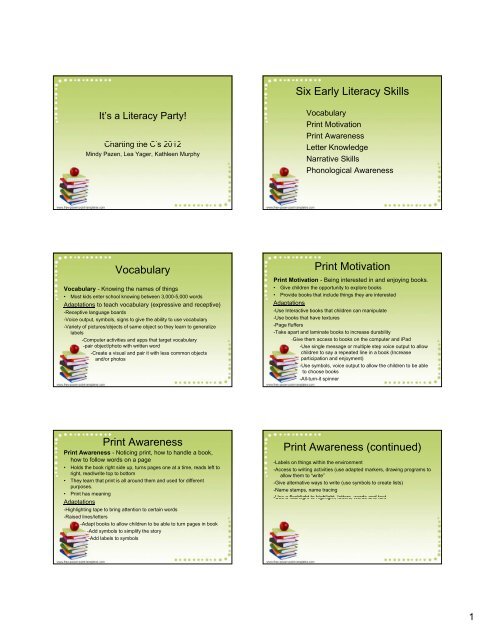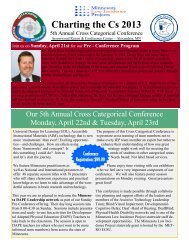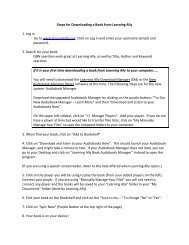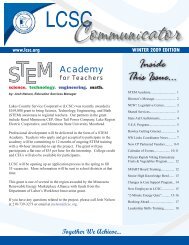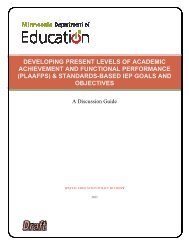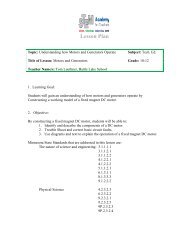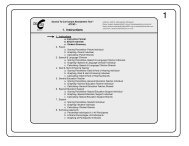PowerPoint Handout
PowerPoint Handout
PowerPoint Handout
You also want an ePaper? Increase the reach of your titles
YUMPU automatically turns print PDFs into web optimized ePapers that Google loves.
Six Early Literacy SkillsIt’s a Literacy Party!Charting the C’s 2012Mindy Pazen, Lea Yager, Kathleen MurphyVocabularyPrint MotivationPrint AwarenessLetter KnowledgeNarrative SkillsPhonological AwarenessVocabularyVocabulary - Knowing the names of things• Most kids enter school knowing between 3,000-5,000 wordsAdaptations to teach vocabulary (expressive and receptive)-Receptive language boards-Voice output, symbols, signs to give the ability to use vocabulary-Variety of pictures/objects of same object so they learn to generalizelabels-Computer activities and apps that target vocabulary-pair object/photo with written word-Create a visual and pair it with less common objectsand/or photosPrint MotivationPrint Motivation - Being interested in and enjoying books.• Give children the opportunity to explore books• Provide books that include things they are interestedAdaptations-Use Interactive books that children can manipulate-Use books that have textures-Page fluffers-Take apart and laminate books to increase durability-Give them access to books on the computer and iPad-Use single message or multiple step voice output to allowchildren to say a repeated line in a book (Increaseparticipation and enjoyment)-Use symbols, voice output to allow the children to be ableto choose books-All-turn-it spinnerPrint AwarenessPrint Awareness - Noticing print, how to handle a book,how to follow words on a page• Holds the book right side up, turns pages one at a time, reads left toright, read/write top to bottom• They learn that print is all around them and used for differentpurposes.• Print has meaningAdaptations-Highlighting tape to bring attention to certain words-Raised lines/letters-Adapt books to allow children to be able to turn pages in book-Add symbols to simplify the story-Add labels to symbolsPrint Awareness (continued)-Labels on things within the environment-Access to writing activities (use adapted markers, drawing programs toallow them to “write”-Give alternative ways to write (use symbols to create lists)-Name stamps, name tracing-Use a flashlight to highlight, letters, words and text1
Letter KnowledgeLetter Knowledge - Knowing letters are different fromeach other, knowing their names and sounds• Children who go to kindergarten already knowing the shapes andnames of the letters of the alphabet and how to write them, have aneasier time learning how to read.Adaptations-Allowing access to computer activities and apps that focus on letterknowledge-Use colored glue or puffy paint to raise the lines of the letters (caneasily trace the lines)-Multisensory ways to practice writing letters (increasesengagement)- Use single message voice (or step-by-step) output to singthe alphabet songLetter Knowledge (continued)-Magnetic letters to allow them to put letters together, match letters-Voice output to allow them to identify written letters or talkabout letters-Use single message voice (or step-by-step) output to sing the alphabetsongNarrative SkillsNarrative Skills (continued)Narrative Skills - Being able to describe things and eventsand tell stories• the ability to tell what happened (during daily activities, in books, TVshows/movies)• the ability to sequences events in a logical orderAdaptations-Create motor and verbal response cards (feature, function, class)-Use first/then schedule-Provide a voice output and/or symbols to allow children to talkabout what they see, to re-tell a story of a favorite book-Use voice output/symbols to allow a child to give clues to “What is it?”game or in the “sharing” bag-Sentence strip to say “I see/spy_____” with I Spy game-Communication strategies (symbols, voice output, signs) to allowchildren to describe things-Provide visuals/props when teaching new concepts (i.e. hot/cold,dirty/clean)-Apps that help children sequence activities, teach sequencing skillsPhonological AwarenessPhonological Awareness - Being able to hear and playwith the smaller sounds in words• being able to hear and create rhymes• understanding that individual sounds make up words• letters represent soundspAdaptations-Voice output to allow them to play with rhyming words, identify thesounds letters make-Switch adapted tape recorder to play with songs-Use visuals, gestures, prompts to facilitate appropriatesound production-Clap out syllables (hit a switch to mark syllables)2
Resources• http://www.starfall.com/• http://www.getreadytoread.org• http://professionals.cochlearamericas.com/cochlearacademy/hope-rehabilitation-resources/speech-sounds-guide-for-parents-and-professionals and professionals (pdf)• http://www.nancymusic.com/music-why-sing.htm• http://www.nichd.nih.gov/publications/pubs_details.cfm?from&pubs_id=5698Resources• http://www.littlebooklane.com/• http://www.fpg.unc.edu/~scpp/nat_allies/na_resources.cfm (link to natural resources listserve)• http://www.brillbaby.com• http://www.walearning.com/resources/on-the-go// / th /3


